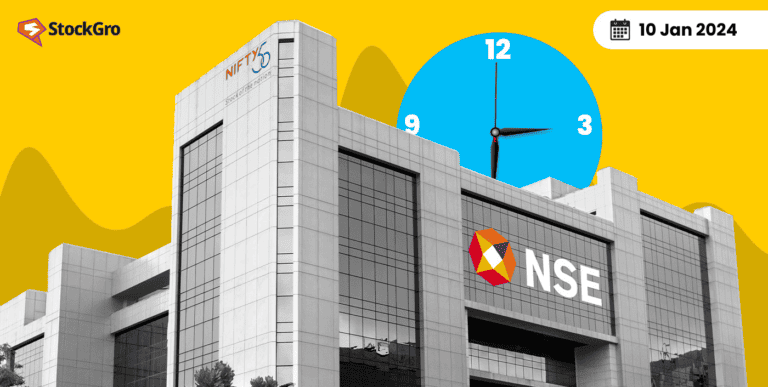Table of contents
Have you ever heard terms like ‘market crash’, ‘bullish market’, and ‘bearish market’ being thrown around and wondered what they are about? The answer is that all of these terms refer to the stock market and the price of shares.
Stock price refers to the price at which a publicly traded company’s share is bought or sold. Many beginners have a common question: How do you calculate share price? Keep reading to find out everything you need to know about share prices.
How are share prices calculated?
There is no exact ‘share price formula’ which determines the prices of shares. Stock exchanges like BSE and NSE have computerised algorithms that account for the demand and supply of stocks and decide the trading price.
The price at which the highest number of trades is said to be the equilibrium price of a share. Amidst constant information and trading, the equilibrium price keeps changing constantly.
You may also like: What is Capital Market – an engaging guide for beginners
Factors affecting the share price
As you learn in Economics 101, demand and supply work together to decide the price of any good or service. Shares are no different. Changes in demand and supply determine the price of shares.
If there are more buyers, there is higher demand, and the share price rises. Conversely, when sellers are more, supply is higher than demand, and the share price falls. But why do demand and supply fluctuate? You can understand this with the help of the following factors:
- Economy: Investing in a stable economy with low unemployment, desirable interest rates, and good growth prospects can lead to gains in the stock market.
- Political and policy-related factors: Changes in business-related government policy, the election of new governments, new budget announcements, and other political and policy-related factors affect the stock market sentiment.
- Company Announcements: Investors use company financials to decide on buying, holding, or selling shares. Dividends, stock splits, and management changes also affect share prices.
- Industry Growth: The nature of the industry that a company operates in significantly impacts its share price. Apart from this, if an industry is such that the bargaining power of customers or suppliers is higher, investors favour it more.
- Liquidity: Liquidity is how easily a share can be traded without changing its price. A higher liquidity means more investors trade it. The bid price is the buying cost, the asking price is the selling value, and the difference is the bid-ask spread.
- Volume: The trade volume of a share is the measure of the liquidity of a stock and refers to the number of trades that occur within a particular period. If a share has a low trading volume, its share price is more volatile and vice versa.
- International Affairs: Global events like wars, government changes, and trade agreements can affect India’s stock market, often in sync with the US S&P 500 index.
Why does the share price change so frequently?
Thanks to the internet, information is now available at one’s fingertips. Investors constantly receive news from financial news websites, newspapers, social media, finance apps, etc.
As a result, everyone’s reaction to the information is also quicker and is reflected immediately in share prices.
It can be hard to keep up with changing prices, but moves like seeking professional advice, tracking metrics like 52-week low or high, and others could help you stay on top of the trading game.
Also Read: A guide to stock dividend
What is intrinsic value, and how is it calculated?
All this while, we were discussing the market price of the share. However, there is another price called the intrinsic value of the stock. This price reflects what a stock is truly worth based on the company’s fundamentals like financial health and other such parameters.
The intrinsic value of a stock is essential as it helps investors determine if stocks are undervalued or overvalued.
A higher intrinsic value relative to its market share price indicates an undervalued stock and vice versa. Investing in undervalued shares will yield profitable results in the long run.
You can calculate the intrinsic value of a share using the following methods:
- Dividend discount model
- Discounted cash flow
- Relative Valuation Method
Conclusion
In conclusion, the share price is the price at which a share is traded on a stock exchange. Comprehending the factors that affect share price and learning about concepts like the intrinsic value of a stock can help you make sound investment decisions and develop an effective trading strategy.
FAQs
A share price is the price at which traders can buy and sell shares in the market. It generally refers to the market price of shares fluctuating based on the demand and supply.
The cost spent on the same quantity of shares varies occasionally, given the changing prices in the stock market. To calculate the average cost per share, an investor must divide the total purchase amount by the total number of shares purchased.
One way to decide the share price during an IPO is to allow underwriters to determine it before the IPO launch based on the company’s background and requirements. Another option is the book-building process, where the price depends on the total demand after the bidding date.
When the market value of shares exceeds their face values, it suggests they are trading at a premium. This indicates an increased demand from investors towards these shares. When market value is lesser than face value, shares are traded at a discount.
The book value of a stock refers to the value of stocks as represented on the company’s balance sheet. The total liabilities are deducted from the total asset value and divided by the number of shares issued to the public to determine the book value per share.
